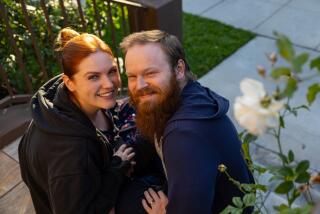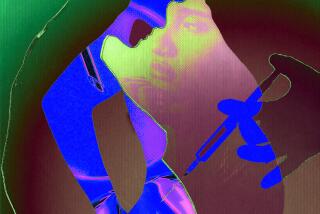Runs in the family
- Share via
“This is Christina.” The voice on the answering machine said that and nothing more. When Phillip tried to place the name and voice, he drew a blank. A few days later, Christina managed to deliver the rest of the message: A long time ago, you were a sperm donor. I’m your offspring. I turned out “pretty good,” and I’d like to meet you.
“I had to listen to that message four or five times to have it sink in,” Phillip said.
So commenced the latest chapter in a saga of the evolving American family -- if “family” is the right word. The prologue dates to 1982, when the Oakland-based Feminist Women’s Health Clinic created the nonprofit Sperm Bank of California to serve unmarried heterosexual women and lesbians, who were customarily turned away from the for-profit operations that dominated the field.
The Sperm Bank of California also offered another pioneering option: contracts that would assure that the children, upon reaching legal age, could learn the identity and additional information about the men who made their particular DNA possible. Such arrangements are still exceptional; donor confidentiality is the rule.
Last weekend’s private meeting between Christina and Phillip is believed to be the first personal encounter between an offspring and a donor, according to sperm bank officials. Christina, sperm bank representatives say, is among about 30 children conceived under the program who have reached their 18th birthday. Only a few have requested the identity of the donor; others have said they prefer to wait or have expressed no interest.
Although it’s possible other meetings have taken place, Christina and Phillip, who have requested that their last names and cities of residence not be disclosed, are the first to have discussed their budding relationship. And both Christina and Phillip, a 44-year-old nurse’s aid in a San Francisco Bay Area trauma center, predict it will be a lasting one.
In separate interviews, both describe a quick and strong personal chemistry that, they figure, may be rooted in their genetic kinship. Both, however, avoid the emotion-laden terms “daughter” or “father,” despite the biological validity.
“He’s a really positive person. Our chemistry just clicked,” Christina said. “I think we can be really good friends.”
“I can be like her godfather. I’ll make her an offer she can’t refuse,” Phillip joked.
In a sense, Phillip made such an offer when he first answered an ad for donors placed by the Sperm Bank of California. At the time, Phillip says, “I didn’t see marriage on the horizon at all.” The oldest of six children, Phillip said he had been raised in a loving family, and the idea of helping others create such a family appealed to him.
The data sheet the sperm bank compiled for Phillip held special appeal for a woman named Mary. In an interview, Mary recalled how she was then a divorced mother of two, with her 40th birthday a few years away, and how she knew she wanted another child. Mary, who is white, said she also knew she wanted an African American donor, because her children were biracial.
“I just wanted them to match. My daughter would say, ‘Oh, Mom, you just wanted us color-coordinated.’ But if I picked another race, that child might feel out of sync.”
*
Put aside the list
And she was pleased that Phillip had agreed to the identity-release option: “I wanted my child to have the option of learning more about who she is.” Mary says she always told Christina the truth about her conception. “She heard the words ‘artificial insemination’ from a very young age.” Christina, who graduated from high school this year and lives in a city near the Oregon border, says she has always been comfortable with the unorthodox nature of her conception.
When Phillip returned her call, she says, they talked for more than two hours. More phone conversations followed, and photographs were exchanged.
“I was a little nervous at first,” Phillip said. Initially, the conversation was so stilted, he said, that he asked Christina if she was reading questions from a list. In fact, she was.
Phillip suggested that she put the list aside and just ask him anything that popped into her mind.
“Do you have big feet?” Christina asked.
Yes.
Christina also wondered if Phillip’s sense of humor had ever gotten him in trouble. Again, the answer was yes. Phillip said he told Christina that he has had a tendency to be sarcastic, “but I’ve learned to dial it down.”
Beyond the big feet and sarcasm, other similarities, physical and otherwise, have been detected in the two. Mary, who went with her daughter to meet Phillip, was taken aback by his big brown eyes. “It was looking at my daughter’s eyes in another person’s face.”
Others have noted that while Mary is a large woman, Christina is petite. Phillip is 5 feet 6 and stocky.
Phillip’s friend Harvey Silket, who attended and photographed part of the private meeting, said he was most struck by the similarities of their personalities. “I was surprised. I thought it would be awkward, but it wasn’t. It was like they had known each other for a couple of years.”
Phillip and Christina have gregarious, upbeat personalities that come across in interviews.
“I’m completely outgoing and spontaneous. Definitely a wild child,” Christina said with a laugh. As for his own wild credentials, Phillip has bungee-jumped and once fire-walked in a motivational seminar led by Anthony Robbins.
They also shared some interests. Both enjoy reading Stephen King. And while Phillip works as a nurse’s aide, Christina has plans to become a licensed vocational nurse. This medical training, she said, would help her in a long-term goal of entering UC Davis and becoming a forensic scientist.
Christina says she now hopes to meet Phillip’s daughter and son, twin 9-year-olds who are her genetic half-siblings. Phillip, who is separated from his wife, says he’s trying to arrange it. Christina also hopes to meet six other genetic half-siblings in four other families who, like her, were conceived through Phillip’s deposits at the sperm bank.
Three of Phillip’s offspring are expected to turn 18 this year. “Oooh, that’s a lot to think about,” he said. “I’m still absorbing everything that’s happened. If they want to meet me, that will be arranged.”
Christina wonders about those genetic half-siblings as well. When she was born, her siblings were 14 and 10 so, she says, she has longed for a brother or sister closer to her own age. Discovering and getting to know Phillip’s other offspring, she says, would be “kind of like having a big family, and I always wanted to have a big family.”


